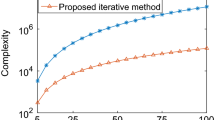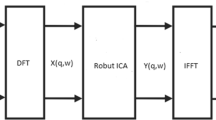Abstract
Independent component analysis (ICA) is one of the most powerful techniques to solve the problem of blind source separation (BSS), and the well-known Fast-ICA is excellent for large-scale BSS. Fast-ICA tries to find the demixing matrix by optimizing the nonlinear objective (cost or contrast) functions. For Fast-ICA, there are three built-in contrast functions to separate non-Gaussian sources, and their derivatives are similar to nonlinearities used in neural networks. However, the contrast functions and their nonlinearities for separating super-Gaussian sources are not optimal owing to their high computational cost, which greatly affect the convergence rate of Fast-ICA. To address this issue, this paper proposes two rational nonlinearities to replace the built-in (original) nonlinearities. The rational nonlinearities are derived by the Chebyshev–Pade approximant from Chebyshev polynomials (series) of the original nonlinearities. To speed up the convergence of Fast-ICA, the degrees in both numerator and denominator of rational functions are designed to be relatively low, and thus the rational polynomials can be quickly evaluated. Simulation results of audio BSS show that the proposed rational nonlinearities can not only improve the convergence rate of Fast-ICA, but also improve the separation performance index; Experiment results of real electrocardiogram data also verify the validity of the proposed approach.













Similar content being viewed by others
References
T. Adali, C. Jutten, A. Yeredor, A. Cichocki, E. Moreau, Source separation and applications. IEEE Signal Process. Mag. 31(3), 16–17 (2014)
T. Adali, V.D. Calhoun, Complex ICA of brain imaging data. IEEE Signal Process. Mag. 24(5), 136–139 (2007)
J. Antoni, Cyclic spectral analysis in practice. Mechan. Sys. Signal Process. 21, 597–630 (2007)
J.P. Boyd, Chebyshev expansion on intervals with branch points with application to the root of Kepler’s equation: a Chebyshev–Hermite–Pade method. J. Comput. Appl. Math. 223, 693–702 (2009)
J.C. Butcher, Order and stability of generalized Pade approximations. Appl. Num. Math. 59, 558–567 (2009)
C. Capdessus, A.K. Nandi, Extraction of a cyclostationary source using a new cost function without prewhitening. Signal Process. 9(11), 2497–2505 (2011)
R. Chai, G.R. Naik, T.N. Nguyen, S.H. Ling, Y. Tran, A. Craig, H.T. Nguyen, Driver fatigue classification with independent component by entropy rate bound minimization analysis in an EEG-based system. IEEE J. Biomed. Health Inform. (2016). doi:10.1109/JBHI.2016.2532354
P. Comon, Independent component analysis, a new concept? Signal Process. 36, 287–314 (1994)
P. Comon, C. Jutten, Handbook of Blind Source Separation: Independent Component Analysis and Applications (Academic, New York, 2010)
R.M. Corless, N. Fillion, A Graduate Introduction to Numerical Methods: From the Viewpoint of Backward Error Analysis (Springer, New York, 2013)
A. Cuyt, Pade Approximants for Operators: Theory and Applications (Springer, Heidelberg, 1984)
H.H. Denman, Minimax polynomial approximation. Math. Comput. 20, 257–265 (1966)
J.B. Farr, S. Gao, Grobner bases and generalized Pade approximation. Math. Comput. 75(253), 461–473 (2005)
R. Ge, L. Yao, H. Zhang, Z. Long, A two-step super-Gaussian independent component analysis approach for fMRI data. NeuroImage 118, 344–358 (2014)
A.P. Golub, Generalized moment representations and Pade–Chebyshev approximations. Ukrainian Math. J. 42(6), 672–676 (1990)
F. Gu, H. Zhang, D. Zhu, Blind separation of non-stationary sources using continuous density hidden Markov models. Digit. Signal Process. 23(5), 1549–1564 (2013)
J. Guo, Y. Deng, A time-frequency algorithm for noisy ICA. Third International Conference Geo-Informatics in Resource Management and Sustainable Ecosystem (GRMSE 2015) (Springer, Berlin 2016), pp. 357–365
Y. Guo, G.R. Naik, H. Nguyen, Single channel blind source separation based local mean decomposition for biomedical applications. In the Proceedings of IEEE Engineering in Medicine and Biology Society (Osaka, 2013), pp. 6812–6815
Y. Guo, S. Huang, Y. Li, G.R. Naik, Edge effect elimination in single-mixture blind source separation. Circuit. Sys. Signal Process. 32(5), 2317–2334 (2013)
M. Haritopoulos, C. Capdessus, A.K. Nandi, Foetal PQRST extraction from ECG recordings using cyclostationarity-based source separation method. In Annual International Conference of the IEEE Engineering in Medicine and Biology Society (Buenos Aires, 2010). doi:10.1109/IEMBS.2010.5627304
X. He, F. He, T. Zhu, Large-scale super-Gaussian sources separation using Fast-ICA with rational nonlinearities. Int. J. Adapt. Control Signal Process. 31, 379–397 (2017)
X. He, F. He, W. Cai, Underdetermined BSS based on K-means and AP clustering. Circuit. Sys. Signal Process. 35(8), 2881–2913 (2016)
X. He, T. Zhu, ICA of noisy music audio mixtures based on iterative shrinkage denoising and FastICA using rational nonlinearities. Circuit. Sys. Signal Process. 33(6), 1917–1956 (2014)
J. Himberg, A. Hyvarinen, F. Esposito, Validating the independent components of neuroimaging time series via clustering and visualization. NeuroImage 22, 1214–1222 (2004)
E.J. Hinch, Perturbation Methods (Cambridge University Press, New York, 1991)
M.H. Holmes, Introduction to Perturbation Methods, 2nd edn. (Springer, New York, 2013)
A. Hyvarinen, Fast and robust fixed-point algorithms for independent component analysis. IEEE Trans. Neural Netw. 10(3), 626–634 (1999)
A. Hyvarinen, J. Karhunen, E. Oja, Independent Component Analysis (Wiley, New York, 2001)
O. Karpenkov, Geometry of Continued Fractions (Springer, Heidelberg, 2013)
Z. Koldovský, P. Tichavský, E. Oja, Efficient variant of algorithm FastICA for independent component analysis attaining the Cramer–Rao lower bound. IEEE Trans. Neural Netw. 17(5), 1265–1277 (2006)
L. Komzsik, Approximation Techniques for Engineers (Taylor & Francis Group, Boca Raton, 2007)
L.D. Lathauwer, B.D. Moor, J. Vandewalle, Fetal electrocardiogram extraction by blind source subspace separation. IEEE Trans. Biomed. Eng. 47(5), 567–572 (2000)
K.U. Leuven. DaISy, ESAT/SISTA, (1999). Database for the Identification of Systems at http://homes.esat.kuleuven.be/~smc/daisy/
H. J. Maehly, Rational approximations for transcendental function. Proceedings of the International Conference on Information Processing (London, 1960), pp. 57–62
J.C. Mason, D. Handscomb, Chebyshev Polynomials (Chapman & Hall/CRC, Boca Raton, 2003)
A.C. Matos, Integral representation of the error and asymptotic error bounds for generalized Pade type approximants. J. Comput. Appl. Math. 77, 239–254 (1997)
G.R. Naika, Measure of quality of source separation for sub- and super-Gaussian audio mixtures. Informatica 23(4), 581–599 (2012)
G.R. Naik, A.H. Al-Timemy, H.T. Nguyen, Transradial amputee gesture classification using an optimal number of sEMG sensors: an approach using ICA clustering. IEEE Trans. Neural Sys. Rehabil. Eng. 24(8), 837–846 (2016)
G.R. Naik, S.E. Selvan, H.T. Nguyen, Single-channel EMG classification with ensemble-empirical-mode-decomposition-based ICA for diagnosing neuromuscular disorders. IEEE Trans. Neural Sys. Rehabil. Eng. 24(7), 734–743 (2016)
G.R. Naika, W. Wang, Audio analysis of statistically instantaneous signals with mixed Gaussian probability distributions. Int. J. Electron. 99(10), 1333–1350 (2012)
G.R. Naik, W. Wang, Blind Source Separation: Advances in Theory, Algorithms and Applications (Springer, Heidelberg, 2014)
M. Novey, T. Adalı, Complex ICA by negentropy maximization. IEEE Trans. Neural Netw. 19(4), 596–609 (2008)
E. Oja, Convergence of the symmetrical FastICA algorithm. 9th International Conference on Neural Information Processing (ICONIP) (Singapore, 2002), pp. 1368–1372
E. Ollila, V. Koivunen, Complex ICA using generalized uncorrelating transform. Signal Process. 89, 365–377 (2009)
C.B. Papadias, Globally convergent blind source separation based on a multiuser kurtosis maximization criterion. IEEE Trans. Signal Process. 48(12), 3508–3519 (2000)
G. Pendharkar, G.R. Naik, H.T. Nguyen, Using blind source separation on accelerometry data to analyze and distinguish the toe walking gait from normal gait in ITW children. Biomed. Signal Process. Contr. 13, 41–49 (2014)
L.E.D. Persia, D.H. Milone, Using multiple frequency bins for stabilization of FD-ICA algorithms. Signal Process. 119, 162–168 (2016)
G.M. Phillips, Interpolation and Approximation by Polynomials (Springer, New York, 2003)
W.H. Press, S.A. Teukolsky, W.T. Vetterling, B.P. Flannery, Numerical Recipes, The Art of Scientific Computing, 3rd edn. (Cambridge University Press, New York, 2007)
H. Shen, M. Kleinsteuber, K. Huper, Local convergence analysis of FastICA and related algorithms. IEEE Trans. Neural Netw. 19(6), 1022–1032 (2008)
P. Tichavský, Z. Koldovský, E. Oja, Speed and accuracy enhancement of linear ICA techniques using rational nonlinear functions. 7th International Conference, ICA 2007 (London, 2007), pp. 285–292
P. Tichavský, Z. Koldovský, E. Oja, Performance analysis of the FastICA algorithm and Cramer–Rao bounds for linear independent component analysis. IEEE Trans. Signal Process. 54(4), 1189–1203 (2006)
N. Trefethen, Approximation Theory and Approximation Practice (SIAM, Philadelphia, 2013)
S.V. Vaseghi, Advanced Digital Signal Processing and Noise Reduction, 4th edn. (Wiley, Chichester, 2008)
E. Vincent, N. Bertin, R. Gribonval, F. Bimbot, From blind to guided audio source separation. IEEE Signal Process. Mag. 31(3), 107–115 (2014)
C. Yuan, X. Sun, L.V. Rui, Fingerprint liveness detection based on multi-scale LPQ and PCA. China Comm. 13(7), 60–65 (2016)
M. Zhang, M. Haritopoulos, A.K. Nandi, Fetal ECG subspace estimation based on cyclostationarity. Proceedings of the 24th European Signal Processing Conference(Budapest, 2016), pp. 2060–2064
Acknowledgements
Funding for this work was supported by the National Natural Science Foundation of China [No. 60572183] and the Research Projects of the Open Fund Project of Key Laboratory in Hunan Universities [No. 14K022].
Author information
Authors and Affiliations
Corresponding author
Rights and permissions
About this article
Cite this article
He, Xs., He, F. & He, Al. Super-Gaussian BSS Using Fast-ICA with Chebyshev–Pade Approximant. Circuits Syst Signal Process 37, 305–341 (2018). https://doi.org/10.1007/s00034-017-0554-1
Received:
Revised:
Accepted:
Published:
Issue Date:
DOI: https://doi.org/10.1007/s00034-017-0554-1




